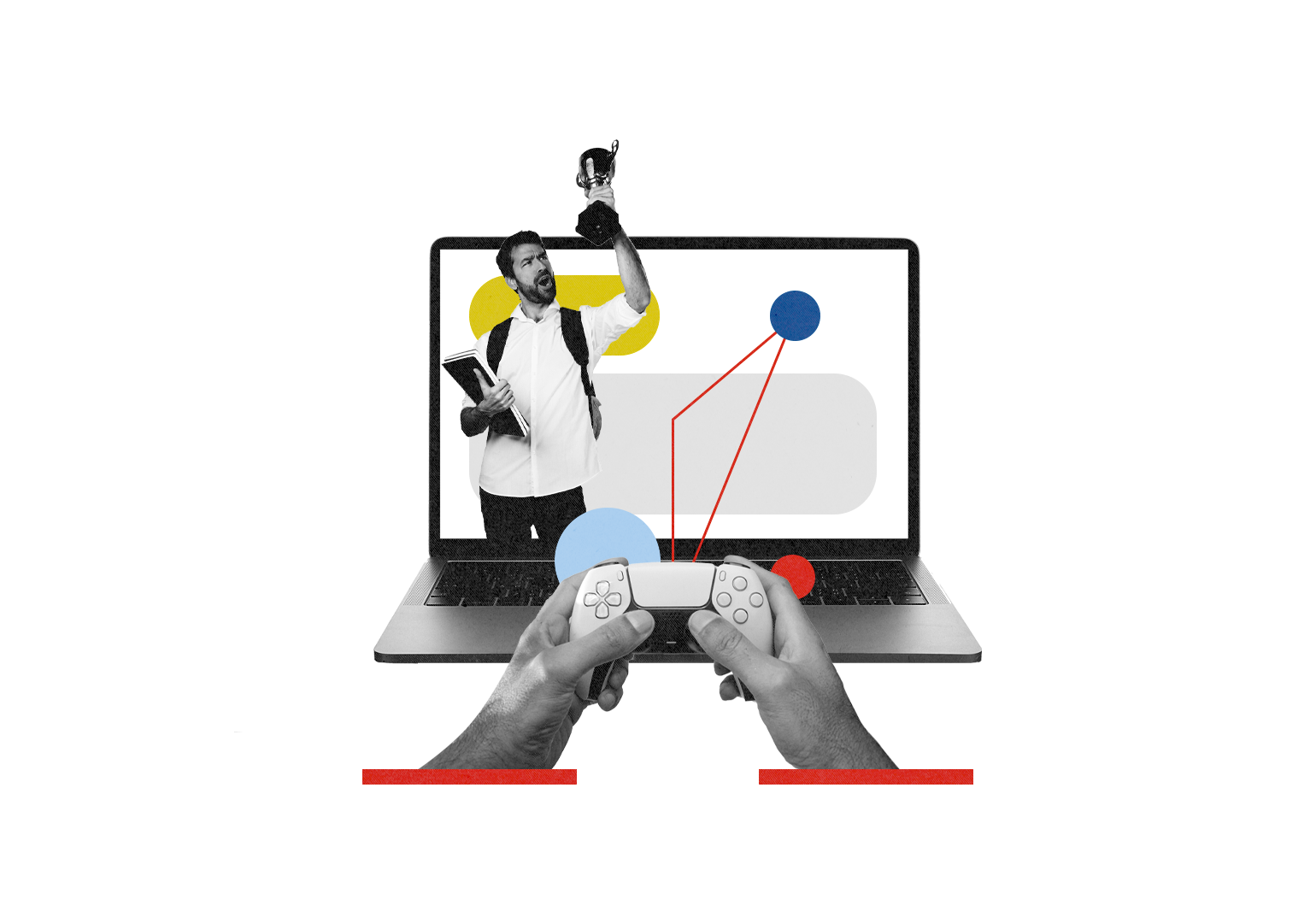Gamification is a design that places the most emphasis on human motivation in the process. In essence, it is Human-Focused Design (as opposed to “function-focused design”).
Gamification – the buzzword that’s been hanging around like that one friend who never knows when the party’s over. It’s not rocket science, folks: slap some game mechanics onto your dreary task, and voilà, it’s suddenly ‘fun.’ Right?
No, not really.
Making money is awesome but what people really crave is a cash-meets-fun combo.
We’ve got two main reasons why anyone does anything: they either want to, or they’re being strong-armed into it. And let’s face it, nobody likes to be strong-armed. It’s like being told to eat your veggies as a kid. You’ll do it, but you’ll sulk about it.
We don’t want that. We want to be happy while doing something.
The gaming industry was the first to master Human-Focused Design – how to make people do stuff in a way that makes them happy.
Since games have spent decades (or even centuries depending on how you qualify a game) learning how to master motivation and engagement, we are now learning from games, and that is why we call it Gamification.
Enter Yu-Kai Chou and his eight core drivers of gamification. It’s like reading the secret recipe to Coca-Cola, but for making boring stuff fun.
Let’s take them one by one.
- Epic Meaning and Calling
It’s like convincing yourself that your morning jog is saving the planet, one step at a time. A recent survey tells us half the workforce would happily take a pay cut for a job that’s more Captain Planet than a corporate drone.
Today’s workers aren’t just looking for a paycheck; they want to be the hero in their own workplace saga. They want to feel like they’re the chosen ones, on a quest so unique, so vital, that no one else could possibly be doing it. It’s like thinking you’re the only one who understands the lyrics of a deep indie song.
But let’s not kid ourselves, this “chosen one” feeling is as real as my chances of winning the lottery. Yet, it’s this very illusion that gets us out of bed, coffee in hand, ready to change the world… or at least our little corner of it.
- Development and Accomplishment
Think of it like your favorite RPG – it’s not just about slaying the dragon; it’s about the journey to becoming a dragon-slaying legend.
First things first, every good game (or workday) needs a killer storyline. Why? Because stories are to humans what cat videos are to the internet – irresistible. They’re the secret sauce that makes us care about what we’re doing, even if it’s as mundane as filing reports.
But here’s the kicker: the game’s all about progress. It’s like watching your character go from zero to hero, but in real life. You’re leveling up, beating challenges, and maybe even getting some shiny digital bling along the way – hello, leaderboards and badges!
It’s not enough to just do good; we want our names up in lights, even if it’s just on a virtual scoreboard. It’s like getting a gold star in kindergarten – trivial, but oh-so-satisfying. We want proof that we’re not just cogs in the machine; we’re cogs that are outperforming other cogs!
- Empowerment of Creativity and Feedback
To keep the human cogs turning, throw them a puzzle, a riddle, something that gets those neurons firing. It’s like dangling a mystery novel in front of an avid reader – they can’t help but dive in. Encourage them to break out their mental paintbrushes and go Picasso on the problem.
And don’t forget about Feedback.
You can’t just let them paint their masterpiece and then leave it to gather dust in the attic. Show it off, applaud it, give it the spotlight it deserves. It’s like telling a kid their fridge art belongs in the Louvre. It’s not just about solving the puzzle; it’s about being recognized for that Eureka moment.
- Ownership and Possession
Gamers (and let’s face it, all of us) love to own stuff. Not just any stuff, but stuff we’ve battled virtual dragons for. It’s like the digital equivalent of hunting and gathering – except you’re collecting pixels instead of berries.
Owning these virtual goodies does something magical. It makes the game – or any platform, for that matter – stickier.
So, leaving it? That’s like walking away from a piece of yourself. In a world where reality often disappoints, these small possessions are often a source of major comfort.
- Social Influence and Relatedness
The reason online games are addictive is because of other players.
Multiplayer isn’t just a feature; it’s the heart of the gaming universe. It’s where the magic happens. You’ve got your points, badges, leaderboards – the whole digital enchilada. And as you level up, you unlock new toys and tricks.
That’s the hook – it’s social, it’s competitive, it’s addictive.
Why can’t we use this we use this in UX design?
- Scarcity and Impatience
Ever tried to watch a video on a slow internet connection? That’s our brains on scarcity. It’s like being on a diet and dreaming of donuts – the less you have, the more you want.
Games are like life on fast-forward. You click, something awesome happens. It’s instant gratification
It’s a cycle of wanting, waiting, and wanting some more. That’s the game’s secret weapon: the more it withholds, the more you’re dying to get it. It’s human nature – we’re all just kids who really, really want that toy on the top shelf.
That’s why “limited time offers” work by the way.
- Unpredictability and Curiosity
Researchers from Open AI — the singularity-focused think-tank co-founded by Elon Musk — recently published a research paper detailing a large-scale study on curiosity-driven learning. Basically what they did was that they gave “curiosity” to AI. What happened next? It played games the whole day.
According to the team’s whitepaper:
“This is not as strange as it sounds. Developmental psychologists talk about intrinsic motivation (i.e., curiosity) as the primary driver in the early stages of development: Babies appear to employ goalless exploration to learn skills that will be useful later on in life. There are plenty of other examples, from playing Minecraft to visiting your local zoo, where no extrinsic rewards are required.
…
The more times the bricks are stuck in a row by the ball, the more complicated the pattern of bricks remaining becomes, making the agent more curious to explore further, hence, collecting points as a by-product. Further, when the agent runs out of lives, the bricks are reset to a uniform structure again that has been seen by the agent many times before and is hence very predictable, so the agent tries to stay alive to be curious by avoiding reset by death.
…
The idea is that local sources of entropy in an environment like a TV that randomly changes channels when an action is taken should prove to be an irresistible attraction to our agent. We take this thought experiment literally and add a TV to the maze along with an action to change the channel.”
Even AI, if you give it a TV and a remote, becomes a couch potato.
- Loss and Avoidance
Nobody likes losing their stuff, even if it’s just pixels on a screen.
this all stems from good old-fashioned fear. Fear of loss, fear of missing out – you name it. Fear gets a bad rap, but let’s give credit where it’s due – it’s an incredible motivator. It’s like the adrenaline rush you get when you’re the last one standing in a game of tag.
In the world of gaming (and life), fear of loss is a powerful driver. It keeps us coming back, grinding away, just to keep our digital treasures safe. It’s not just about the joy of gaining; it’s about the terror of losing.
Fear – it’s what keeps the digital world spinning.
Co-founder & Growth Lead at Kernel











